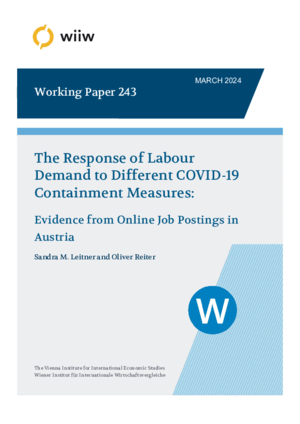The Response of Labour Demand to Different COVID-19 Containment Measures: Evidence from Online Job Postings in Austria
Sandra M. Leitner and Oliver Reiter
wiiw Working Paper No. 243, March 2024
58 pages including 10 Tables and 13 Figures
This paper analyses changes in the speed of labour demand for new hires in response to the lockdowns that were repeatedly put in place to contain the spread of the COVID-19 pandemic. It tests whether the uncertainty-reducing effect of similar lockdowns occurring in quick succession increased the responsiveness of the labour market, thereby allowing for more rapid adjustment, both at the beginning and at the end of subsequent lockdowns. It uses high-frequency online job-posting data and applies an event study approach to the beginning of three national lockdowns and the subsequent reopening in Austria between 2020 and 2022. In view of the importance of progress in vaccination for labour market recovery, it also looks at vaccine roll-out as an additional COVID-19 containment measure, with 2021 as the main roll-out period. The results indicate very different responses to the three lockdowns, with a decline in job-posting activity of between 47% and 50% during the first lockdown and of between 29% and 31% during the second; but an increase of 23% to 28% during the last lockdown. Moreover, responses to the first lockdown were sluggish, with a slow decline at the beginning and a very slow recovery after it was lifted; but over subsequent lockdowns the responses were more rapid and more symmetrical. Responses to the various events differed by occupation and industry: the strongest responses were to be observed in the highly skilled and more-teleworkable occupations of technicians, and managers and professionals, who were badly affected during the first lockdown; the leisure and hospitality industry, which was the hardest hit on account of the mandatory closures and the widespread travel restrictions and bans, and which recovered only very slowly; and the IT, internet and telecommunications industry, where posting activity developed in a direction opposite to that seen in the other industries. Finally, there is little robust evidence of a differentiated effect of vaccinations during lockdowns, suggesting that vaccination roll-out did not have an additional demand-generating effect, over and above the lockdowns.
Keywords: online job posting, COVID-19, teleworkability, vaccinations, event study analysis
JEL classification: J23, J63, O33, G14
Countries covered: Austria
Research Areas: Labour, Migration and Income Distribution
